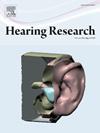单侧突发性感音神经性听力损失的功能连接改变与预后相关
IF 2.5
2区 医学
Q1 AUDIOLOGY & SPEECH-LANGUAGE PATHOLOGY
引用次数: 0
摘要
目的突发性感音神经性听力损失(SSNHL)是一种严重的耳科急症,其特征是听力迅速下降,主要影响一只耳朵。SSNHL的确切病因尚不清楚,这使诊断和治疗都变得复杂。本研究旨在探讨单侧SSNHL患者与预后相关的功能连接(FC)的变化,从而增强我们对与临床结果相关的潜在神经相关性的理解。材料和方法本研究纳入111例单侧SSNHL患者,对其进行听力学评估和功能磁共振成像(fMRI)扫描,重点关注FC变化与预后的关系。结果有效组(n = 72)和无效组(n = 39)在发病至治疗持续时间和出现头晕情况方面差异有统计学意义。与有效组相比,预后不良组双侧颞上回(STG)与左侧海马、右侧边缘上回(SMG)、左侧额叶中回(MFG)和右侧楔前叶之间的FC显著增加。结论本研究强调了研究SSNHL患者FC改变的意义。这些发现表明FC改变与患者预后之间存在潜在关联,这可能有助于未来对SSNHL神经机制的研究。本文章由计算机程序翻译,如有差异,请以英文原文为准。
Alterations in functional connectivity related to prognosis in unilateral sudden sensorineural hearing loss
Objectives
Sudden Sensorineural Hearing Loss (SSNHL) is a critical otological emergency characterized by a rapid decline in hearing, primarily affecting one ear. The exact cause of SSNHL remains unclear, which complicates both diagnosis and treatment. This study aimed to explore changes in functional connectivity (FC) related to prognosis in patients with unilateral SSNHL, thereby enhancing our understanding of the potential neural correlates associated with clinical outcomes.
Materials and Methods
The study involved 111 patients diagnosed with unilateral SSNHL, who underwent audiological evaluations and functional magnetic resonance imaging (fMRI) scans, focusing on changes in FC related to their prognosis.
Results
Significant differences were found between the effective (n = 72) and ineffective (n = 39) treatment groups regarding the duration from onset to treatment and the presence of dizziness. Compared with effective group, the cohort with a poor prognosis demonstrated a significant increase in FC between the bilateral superior temporal gyrus (STG) and the left hippocampus, right supramarginal gyrus (SMG), left middle frontal gyrus (MFG), and right precuneus.
Conclusion
The research highlights the significance of investigating the alterations in FC observed in patients experiencing SSNHL. These findings suggest a potential association between altered FC and patient outcomes, which could contribute to future studies on the neural mechanisms underlying SSNHL.
求助全文
通过发布文献求助,成功后即可免费获取论文全文。
去求助
来源期刊

Hearing Research
医学-耳鼻喉科学
CiteScore
5.30
自引率
14.30%
发文量
163
审稿时长
75 days
期刊介绍:
The aim of the journal is to provide a forum for papers concerned with basic peripheral and central auditory mechanisms. Emphasis is on experimental and clinical studies, but theoretical and methodological papers will also be considered. The journal publishes original research papers, review and mini- review articles, rapid communications, method/protocol and perspective articles.
Papers submitted should deal with auditory anatomy, physiology, psychophysics, imaging, modeling and behavioural studies in animals and humans, as well as hearing aids and cochlear implants. Papers dealing with the vestibular system are also considered for publication. Papers on comparative aspects of hearing and on effects of drugs and environmental contaminants on hearing function will also be considered. Clinical papers will be accepted when they contribute to the understanding of normal and pathological hearing functions.
 求助内容:
求助内容: 应助结果提醒方式:
应助结果提醒方式:


